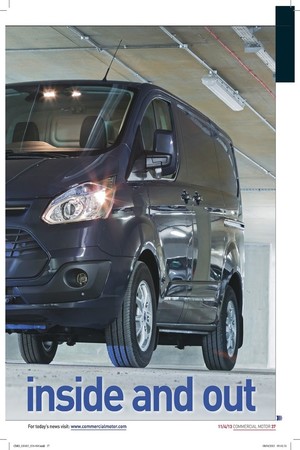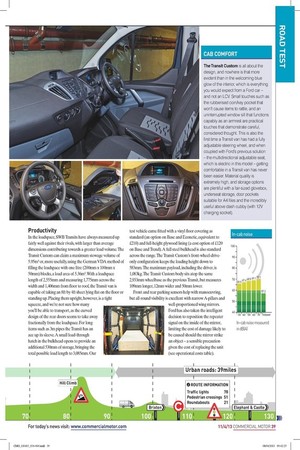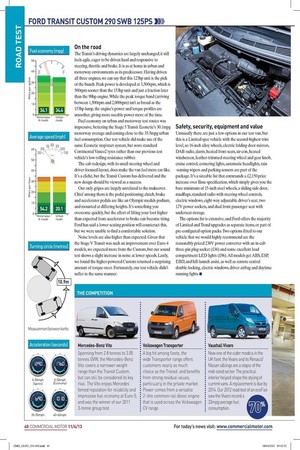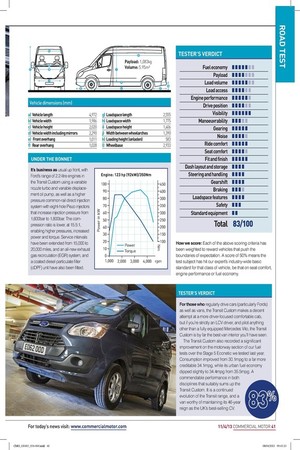inside and out The Transit Custom represents a massive investment
Page 27

Page 28

Page 29

Page 30

Page 31

Page 32

If you've noticed an error in this article please click here to report it so we can fix it.
for Ford, and our testers believe it has been money well spent The Transit Custom has received a raft of awards and widespread recognition since its arrival last year, which is just as well because Ford's mid-sized Transit is replacing its best-selling commercial model and the UK's third best-selling vehicle. Failure is not an option, so Ford's two-stage makeover — updating the Transit's mechanicals to surpass Euro-5 regulations then adding an all-new body — would seem a sensible approach.
To recap, briefly, the old 2.2and 2.4-litre engines have been replaced by a new 2.2-litre Duratorq TDCi unit to improve fuel efficiency and engine emissions. Power outputs for the new engine include 98hp, 122hp and 153hp options, driven exclusively through the front wheels on the new Transit Custom and mated to a six-speed manual gearbox throughout the range.
Torque outputs for each of the three engines are 310Nm, 350Nm and 385Nm, respectively, with peak torque arriving from as low as 1,300rpm.
Shortand long-wheelbase versions of the Transit Custom are available, with gross vehicle weights of 2.5,2.7, 2.9,3.1 and 3.3 tonnes for SWB models, while LWB models will be available at the three highest weights.
The Custom has taken over the smaller end of the previous Transit's range with a cab design said to be focused around the driver. That means implementing a dash layout similar to that of a Ford passenger car, with controls and displays reminiscent of a supersized Ford Focus.
On the outside, rounded edges help create a presence on the road, while narrowing the perceived dimensions to ensure that when the Transit Custom is parked next to a current Transit van, the newer model looks significantly more svelte.
These changes will almost certainly help Ford compete against the Volkswagen Transporter and Mercedes-Benz Vito in the mid-sized van sector.
We have come to expect a certain depth to the Transit range, and the new model is no different when it comes to the interior. From the entry-level Base specification, to the top-of-the-line Sport series with its 18-inch alloys and part-leather seats, the Transit Custom has options and trim levels for every user. Trend and the higher specification limited trim options fill the gap between top and bottom, adding colour-coded bumpers and items such as Ford's new Sync multimedia connectivity package, front and rear parking sensors, air conditioning and heated windscreen among the many additions.
There is also an Econetic specification, which incorporates an automatic stop/start facility with Ford's Advanced Battery Management System and Smart Regenerative Charging to feed power back to the battery during braking.
A larger Transit covering the all important 3.5-tonne weight category, which was shown at this week's CV Show, features a dash layout and design focusing on multiple occupants. For the time being, though, the new Transit range consists of four body styles — minibus, kombi, double-cab van and regular panel van — with prices for the SWB 2.5-tonne panel van starting at £17,495.
Our test vehicle is the 2.9-tonne or 290, SWB Limited model, powered by a 2.2-litre 123hp TDCi engine with the standard six-speed manual. Productivity In the loadspace, SWB Transits have always measured up fairly well against their rivals, with larger than average dimensions contributing towards a greater load volume. The Transit Custom can claim a maximum stowage volume of 5.95m3 or, more usefully, using the German VDA method of filling the loadspace with one litre (200mm x 100mm x 50mm) blocks, a load area of 5.36m3. With a loadspace length of 2,555mm and measuring 1,775mm across the width and 1,406mm from floor to roof, the Transit van is capable of taking an 8ft by 4ft sheet lying flat on the floor or standing up. Placing them upright, however, is a tight squeeze, and we're not sure how many you'll be able to transport, as the curved design of the rear doors seems to take away fractionally from the loadspace. For long items such as 3m pipes the Transit has an ace up its sleeve. A small load-through hatch in the bulkhead opens to provide an additional 530mm of storage, bringing the total possible load length to 3,085mm Our test vehicle came fitted with a vinyl floor covering as standard (an option on Base and Econetic, equivalent to £210) and full-height plywood lining (a cost option of £120 on Base and Trend). A full steel bulkhead is also standard across the range. The Transit Custom's front-wheel-driveonly configuration keeps the loading height down to 583mm The maximum payload, including the driver, is 1,083kg. The Transit Custom body sits atop the same 2,933mm wheelbase as the previous Transit, but measures 109mm longer, 12mm wider and 50mm lower.
Front and rear parking sensors help with manoeuvring, but all-round visibility is excellent with narrow A-pillars and well-proportioned wing mirrors. Ford has also taken the intelligent decision to reposition the repeater signal on the inside of the mirror, limiting the cost of damage likely to be caused should the mirror strike an object — a sensible precaution given the cost of replacing the unit (see operational costs table). On the road The Transit's driving dynamics are largely unchanged; it still feels agile, eager to be driven hard and responsive to steering, throttle and brake. It is as at home in urban and motorway environments as its predecessor. Having driven all three engines, we can say that this 123hp unit is the pick of the bunch. Peak power is developed at 3,500rpm, which is 500rpm sooner than the 153hp unit and just a fraction later than the 98hp engine. While the peak torque band (arriving between 1,500rpm and 2,000rpm) isn't as broad as the 153hp lump, the engine's power and torque profiles are smoother, giving more useable power more of the time.
Fuel economy on urban and motorway test routes was impressive, bettering the Stage 5 Transit Econetic's 30.1mpg motorway average and coming close to the 35.5mpg urban fuel consumption. Our test vehicle did make use of the same Econetic stop/start system, but wore standard Continental Vanco2 tyres rather than our previous test vehicle's low-rolling resistance rubber.
The cab redesign, with its small steering wheel and driver-focused layout, does make the van feel more car-like. It's a cliché, but the Transit Custom has delivered and the new design should be viewed as a success.
Our only gripes are largely unrelated to the makeover. Chief among them is the pedal positioning; clutch, brake and accelerator pedals are like an Olympic medals podium, and mounted at differing heights. It's something you overcome quickly, but the effort of lifting your foot higher than expected from accelerator to brake can become tiring. Ford has said a lower seating position will counteract this, but we were unable to find a comfortable solution.
Noise levels are also higher than expected. Given that the Stage V Transit was such an improvement over Euro-4 models, we expected more from the Custom, but our sound test shows a slight increase in noise at lower speeds. Lastly, we found the higher-powered Custom returned a surprising amount of torque-steer. Fortunately, our test vehicle didn't suffer in the same manner Safety, security, equipment and value Unusually there are just a few options in our test van, but this is a Limited spec vehicle with the second-highest trim level, so 16-inch alloy wheels, electric folding door mirrors, DAB radio, alarm, heated front seats, air-con, heated windscreen, leather-trimmed steering wheel and gear knob, cruise control, cornering lights, automatic headlights, rain -sensing wipers and parking sensors are part of the package. It's a sizeable list that commands a £2,150 price increase over Base specification, which simply gives you the bare minimum of 15-inch steel wheels, a sliding side door, mudflaps, standard radio with steering wheel controls, electric windows, eight-way adjustable driver's seat, two 12V power sockets, and dual front passenger seat with underseat storage.
The options list is extensive, and Ford offers the majority of Limited and Trend upgrades as separate items, or part of pre-configured option packs. Two options fitted to our vehicle that we would highly recommend are the reasonably priced 230V power converter with an in-cab three-pin plug socket (£36) and some excellent load compartment LED lights (£96). All models get ABS, ESP, EBD, and hill-launch assist, as well as remote central double-locking, electric windows, driver airbag and daytime running lights. • SPECIFICATIONS Website vwwv.ford.co.uk Engine Duratorg TDCi common-railturbodiesel Cylinders Four in-line CO2 178g/km Bore x stroke 86 x 94.6 Capacity 2198cc Compression ratio 15.5:1 Maximum power 123hp (92kINJ Id 3,500rpm Maximum torque 350Nm Id 1,500rpm 2,000rpm Transmission Six-speed, manual Gear ratios 3.737, 1.864, 1.121, .0780, 0.844, 0.683, Reverse1.423 Final drive ratio 4.19 Clutch Dry plate, mechanical Brake dimensions Front discs: 288 x 33mm, Rear discs: 288 x16mm Suspension Front: Independent MacPherson struts with variable coil springs, Rear: Leaf springs Steering Power-assisted Tyres ContinentalVanco2 215/65 R1 6C Fuel tank 80 litres Extras fitted Metallic paint (£FOCJ, Load compartment LED lights (£96d, 230V power converler (£36] Basic price £22,566 Test price £22,698 CAB COMFORT TheTransit Custom is all about the design, and nowhere is that more evident than in the welcoming blue glow of the interior, which is everything you would expect from a Ford car — and not an LCV. Small touches such as the rubberised coin/key pocket that won't cause items to rattle, and an uninterrupted window sill that functions capably as an armrest are practical touches that demonstrate careful, considered thought. This is also the first time a Transit van has had a fully adjustable steering wheel, and when coupled with Ford's previous solution — the multidirectional adjustable seat, which is electric in this model — getting comfortable in a Transit van has never been easier. Material quality is extremely high, and storage options are plentiful with a fair-sized glovebox, underseat storage, door pockets suitable for A4 files and the incredibly useful above dash cubby (with 12V charging socket).
THE COMPETITION Mercedes-Benz Vito Spanning from 2.8 tonnes to 3.05 tonnes GVW, the Mercedes-Benz Vito covers a narrower weight range than the Transit Custom, but can still be considered its key rival. The Vito enjoys Mercedes' famed reputation for reliability and impressive fuel economy at Euro-5, and was the winner of our 2011 3-tonne group test. Volkswagen Transporter A big hit among fleets, the wide Transporter range offers customers nearly as much choice as the Transit, and benefits from strong residual values, particularly in the private market. Power comes from a versatile 2-litre common-rail diesel engine that is used across the Volkswagen CV range. Vauxhall Vivaro Now one of the older models in the UK fleet, the Vivaro and its Renault/ Nissan siblings are a staple of the mid-sized sector. The practical interior helped shape the styling of current vans. A replacement is due by 2014. Our 2012 road test of an ecoFlex saw the Viva ro record a 33mpg average fuel consumption. UNDER THE BONNET It's business as usual up front, with Ford's range of 2.2-litre engines in the Transit Custom using a variable nozzle turbo and variable displacement oil pump, as well as a higher pressure common-rail direct injection system with eight-hole Piezo injectors that increase injection pressure from 1,600bar to 1,800bar. The compression ratio is lower, at 15.5:1, enabling higher pressures, increased power and torque. Service intervals have been extended from 15,000 to 20,000 miles, and an all-new exhaust gas recirculation (EGR) system, and a coated diesel particulate filter (cDPF) unit have also been fitted. TESTER'S VERDICT For those who regularly drive cars (particularly Fords) as well as vans, the Transit Custom makes a decent attempt at a more driver-focused comfortable cab, but if you're strictly an LCV driver, and pilot anything other than a fully equipped Mercedes Vito, the Transit Custom is by far the best van interior you'll have seen. The Transit Custom also recorded a significant improvement on the motorway section of our fuel tests over the Stage 5 Econetic we tested last year. Consumption improved from 30.1mpg to a far more creditable 34.1mpg, while its urban fuel economy dipped slightly to 34.4mpg from 35.5mpg. A commendable performance in both disciplines that suitably sums up the Transit Custom. It is a continued evolution of the Transit range, and a van worthy of maintaining its 46-year reign as the UK's best-selling CV







































